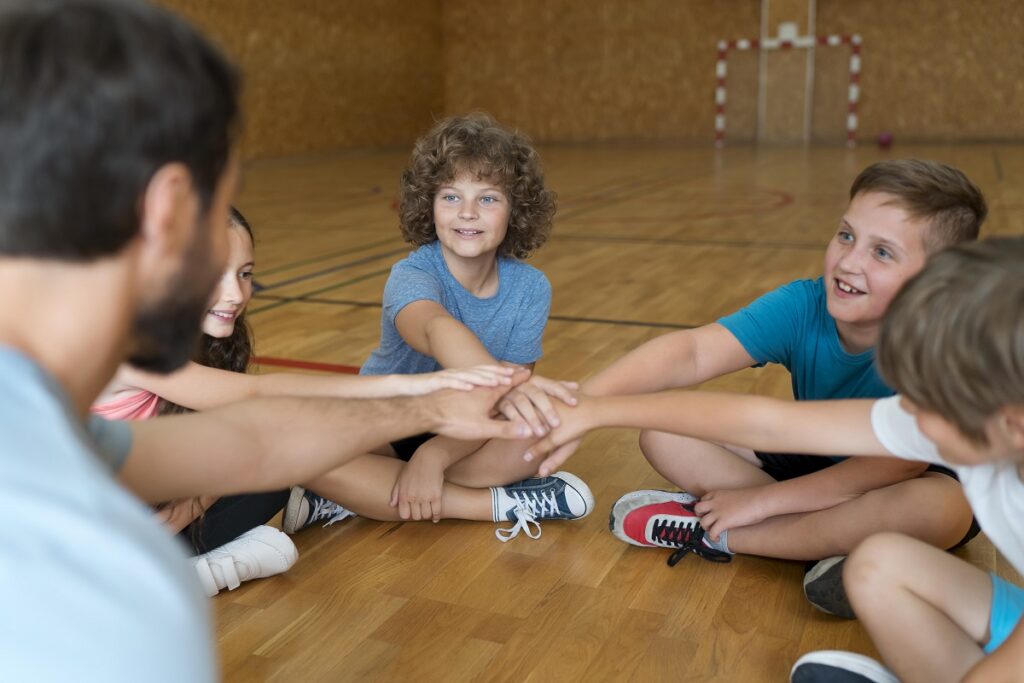Competitions are great opportunities for children to showcase their skills and talent. They are also an excellent chance for personal development and gaining valuable experience. However, competition can sometimes evoke various emotions and stress in children. Therefore, it is important to provide them with appropriate psychological preparation that will help them cope with pressure and maintain a healthy emotional balance.
Here are some useful exercises that can help children prevent potential emotional disturbances related to participating in competitions.
Breathing Techniques
Nowadays, children are often exposed to stress and tension, which can negatively affect their well-being and health. However, we need not worry, as there is an effective way to cope with these challenges – breathing techniques. These simple and accessible methods can help children relax, increase concentration, and improve overall well-being. In this article, you will learn more about breathing techniques for children and how to incorporate them into daily routines.
Abdominal Breathing
One of the simplest breathing techniques that you can teach your child is abdominal breathing. Ask your child to sit or lie down comfortably. Then, ask them to focus on their breath. It is recommended to inhale through the nose for 3-4 seconds and then exhale through the mouth for 3-4 seconds. While performing this technique, encourage your child to focus on the rising and falling of their belly while inhaling and exhaling. Repeat this process for a few minutes until the child feels calm and relaxed.
Counting Breaths
Another simple breathing technique for children is counting breaths. Ask your child to close their eyes and focus on their breath. Then, ask them to count to four while inhaling, and then count to four while exhaling. Repeat this process several times. Counting breaths helps children focus on their breathing and feel inner peace. Continue this exercise, gradually increasing the count of breaths to five, and then slowly decreasing to three. This technique will help the child feel calmer and more focused.
Lotus Flower
The “lotus flower” technique is a fun and interactive breathing exercise for children. Ask your child to imagine that they are enclosed inside a large colorful ball that resembles a lotus flower. Then ask them to breathe in through their nose until their imagination blossoms and becomes beautiful and full of colors. Next, ask the child to exhale through their mouth until the imagination begins to close and return to its original form. Repeat this technique for a few minutes until the child feels relaxed and energized.
Breathing techniques can be useful not only in stressful situations but also in everyday life. Encourage your child to practice these techniques as part of their daily routine. You can set aside a few minutes together for morning and evening breathing sessions. This will be a time when the child can detach from daily worries, calm down, and relax. Remember that children learn by imitation, so show them the benefits of breathing techniques by practicing them together.
Visualization of Success
Every parent wants their child to succeed in life. One of the powerful tools we can use is the visualization of success. Visualization is a technique that allows children to imagine achieving their goals and dreams. It acts like a magic mirror that shows the child what their successes might look like. In this article, you will learn more about the visualization of success in children and how to incorporate it into their daily lives.
Choose a Goal
The first step in visualizing success is to choose a specific goal. Encourage your child to think about what they truly want to achieve. It could be getting a good grade in school, winning first place in a sports competition, or fulfilling their dream of becoming a doctor. It is important that the goal is realistic and tailored to the child’s abilities. After choosing a goal, you can move on to the next step.
Imagine Success
Ask your child to close their eyes and imagine achieving their goal. Encourage them to focus on the details: what the situation looks like, what emotions they feel, what they hear, and what their reactions are. Help them create a vivid picture of their success filled with colors and sounds. The more detailed and realistic the imagination, the stronger the effects of visualization will be.
Positive Affirmations
Affirmations are positive statements that help strengthen the child’s belief in achieving their goal. Ask your child to formulate a few positive affirmations related to their success. For example, if the goal is to pass an exam, the affirmation might be: “I am smart and capable, and passing the exam is an easy task for me.” Encourage the child to repeat the affirmations daily to reinforce their belief in themselves and their abilities.
Creative Visualization
Visualization of success doesn’t have to be limited to just imagination. Encourage your child to create creative projects that represent their goal. This could be a collage, drawing, model, or anything else that allows the child to see their dreams in the real world. This creative visualization will remind the child of their goals and motivate them to take action.
Take Action
Visualization of success is a powerful tool, but it’s not enough to just imagine. It’s important to encourage your child to take actions that will bring them closer to achieving their goal. Help them develop an action plan and support them on their path to success. Show that visualization is just the beginning, and true success requires effort and determination.
Visualization of success is an effective tool that can help children achieve their goals and dreams. By imagining success, using positive affirmations, creating creative projects, and taking action, a child can build faith in their own abilities and motivation to act. Remember that as a parent, you can be a support and inspiration for your child in realizing their dreams. Introduce visualization of success into your child’s daily life and watch as their abilities develop and they fulfill their greatest ambitions.
Conversations About Emotions
Emotions are an inseparable part of our lives. For children, discovering and understanding their emotions can be a challenging task. That’s why it’s so important to talk to children about emotions. Through open and empathetic conversations, we can help children cope with emotions, build healthy relationships, and develop self-awareness. In this article, you will learn why conversations about emotions are important and how you can incorporate them into daily life with your child.
Create a Safe Space
It’s important to create a safe space for the child where they feel free to express their emotions. Assure them that all emotions are normal and important, whether they are positive or negative. Express understanding and empathy towards their feelings, do not trivialize or negate them. This will encourage the child to be open and trusting when talking about emotions.
Name Emotions
Help the child learn to recognize and name emotions. Often, children do not know how to describe their feelings. You can use simple words like joy, sadness, anger, fear, surprise, etc., to help the child identify what they are feeling at that moment. This will enable them to better understand what is happening inside them.
Be patient and listen
During conversations about emotions, remember to be patient and listen. Give the child time to express their feelings and do not interrupt. Ask questions that will help them better understand why they are feeling a certain emotion. Be present and focused on what they are saying. Show the child that you are interested in what they have to say.
Share your emotions
Show the child that you also experience different emotions. Talk about your own emotional experiences and how you cope with them. This will help the child understand that we all feel the same way sometimes and that emotions are a natural part of our lives. Sharing your stories will help build a bond and greater understanding between you and the child.
Look for solutions and strategies
Conversations about emotions should not end with just expressing feelings. Encourage the child to look for solutions and strategies for coping with emotions. You can brainstorm ways to alleviate negative emotions together or set goals that the child would like to achieve to feel better. Practice relaxation breathing techniques together or create lists of things that bring joy. This will help the child build skills for managing emotions.
Relaxation and physical activity
It is important for children to have time to rest and relax before competitions. Together, engage in relaxation exercises such as muscle massage or yoga for children. Also, provide them with opportunities for physical activity that will help them release tension and stress.
Goals and values
Help children understand that participating in competitions is not just about winning, but also about the opportunity to learn and grow. Encourage them to set realistic goals and appreciate their progress regardless of the outcome. Remind them that success is about doing their best and enjoying the experience of participation.
It is important to remember that every child is different and may react differently to the stress of competitions. Therefore, it is worth adapting exercises to the individual needs and abilities of the child. Also, remember that the most important thing is to support and create a positive environment where children feel accepted and loved regardless of the competition outcome.
Preparing children psychologically for competitions is a process that requires time and patience. However, with the help of the above exercises, you can assist your little ones in developing a healthy self-esteem, coping with stress, and enjoying participation in competitions. Remember that the most important thing is for children to feel happy and fulfilled regardless of the outcome, as success is about giving your all and enjoying the journey itself.


